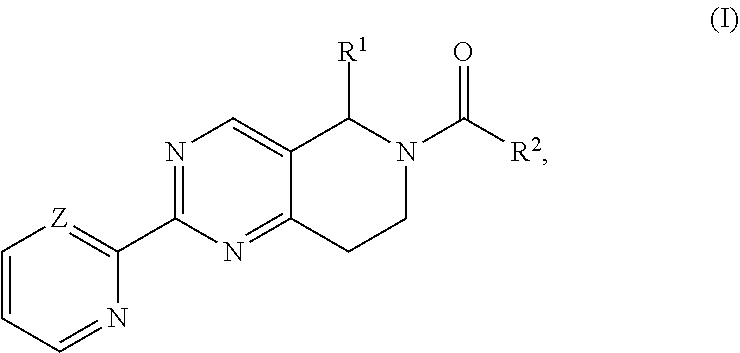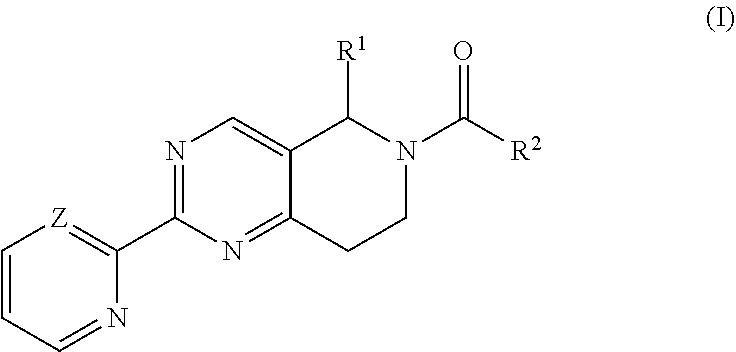Tetrahydropyridopyrimidines for the treatment and prophylaxis of hepatitis B virus infection
a technology of tetrahydropyrimidine and pyrimidine, which is applied in the field of new drugs, can solve the problems of no commercial product approval, chronically infected patients only display weak immune responses, and hbv infection remains a major health problem, and achieve superior anti-hbv activity and treatment or prophylaxis.
- Summary
- Abstract
- Description
- Claims
- Application Information
AI Technical Summary
Benefits of technology
Problems solved by technology
Method used
Image
Examples
example a
[0153]A compound of formula I can be used in a manner known per se as the active ingredient for the production of tablets of the following composition:
[0154]
Per tabletActive ingredient200 mgMicrocrystalline cellulose155 mgCorn starch 25 mgTalc 25 mgHydroxypropylmethylcellulose 20 mg425 mg
example b
[0155]A compound of formula I can be used in a manner known per se as the active ingredient for the production of capsules of the following composition:
[0156]
Per capsuleActive ingredient100.0 mgCorn starch 20.0 mgLactose 95.0 mgTalc 4.5 mgMagnesium stearate 0.5 mg220.0 mg
Indications and Methods of Treatment
[0157]The compounds of the invention can inhibit HBsAg production or secretion and inhibit HBV gene expression. Accordingly, the compounds of the invention are useful for the treatment or prophylaxis of HBV infection.
[0158]The invention relates to the use of a compound of formula I for the inhibition of HBsAg production or secretion.
[0159]The invention relates to the use of a compound of formula I for the inhibition of HBV DNA production.
[0160]The invention relates to the use of a compound of formula I for the inhibition of HBV gene expression.
[0161]The invention relates to the use of a compound of formula I for the treatment or prophylaxis of HBV infection.
[0162]The use of a comp...
example 1
[2-(2-Pyridyl)-7,8-dihydro-5H-pyrido[4,3-d]pyrimidin-6-yl]-[4-(trifluoromethyl)phenyl]methanone
[0200]
Step 1: Preparation of Tert-Butyl 3-(dimethylaminomethylene)-4-oxo-piperidine-1-carboxylate
[0201]
[0202]A mixture of tert-butyl 4-oxopiperidine-1-carboxylate (15.0 g, 0.075 mol) and DMFDMA (9.87 g, 0.0829 mol) in DMF (100 mL) was heated at 90° C. with stirring overnight. The resulting mixture was then concentrated in vacuo and diluted with water (100 mL). The resulting mixture was extracted with EA (30 mL) for three times. The combined organic layer was washed with water, dried over anhydrous Na2SO4 and concentrated in vacuo to give the crude tert-butyl 3-(dimethylaminomethylene)-4-oxo-piperidine-1-carboxylate (13 g) as yellow oil, which was used in the next step directly.
Step 2: Preparation of Tert-Butyl 2-(2-pyridyl)-7,8-dihydro-5H-pyrido[4,3-d]pyrimidine-6-carboxylate
[0203]
[0204]A mixture of tert-butyl 3-(dimethylaminomethylene)-4-oxo-piperidine-1-carboxylate (10 g, 39.37 mmol), py...
PUM
| Property | Measurement | Unit |
|---|---|---|
| pH | aaaaa | aaaaa |
| particle size | aaaaa | aaaaa |
| particle size | aaaaa | aaaaa |
Abstract
Description
Claims
Application Information
 Login to View More
Login to View More - R&D
- Intellectual Property
- Life Sciences
- Materials
- Tech Scout
- Unparalleled Data Quality
- Higher Quality Content
- 60% Fewer Hallucinations
Browse by: Latest US Patents, China's latest patents, Technical Efficacy Thesaurus, Application Domain, Technology Topic, Popular Technical Reports.
© 2025 PatSnap. All rights reserved.Legal|Privacy policy|Modern Slavery Act Transparency Statement|Sitemap|About US| Contact US: help@patsnap.com



